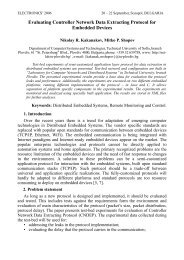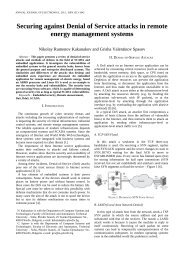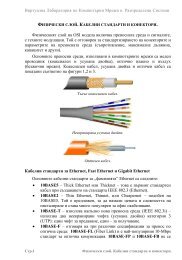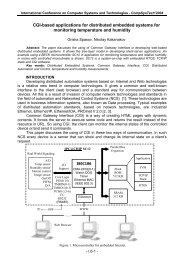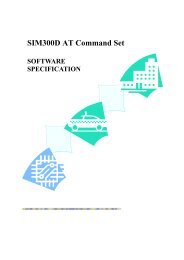Keywords:3-5 keywords (Times New Roman, - Distributed Systems ...
Keywords:3-5 keywords (Times New Roman, - Distributed Systems ...
Keywords:3-5 keywords (Times New Roman, - Distributed Systems ...
You also want an ePaper? Increase the reach of your titles
YUMPU automatically turns print PDFs into web optimized ePapers that Google loves.
ELECTRONICS’ 2005<br />
21 – 23 September, Sozopol, BULGARIA<br />
figure 2.1, a main page is displayed with different sub-menus – figure 2.2. Content of<br />
this page depends on username (Administrator or Guest account) and connection<br />
speed you have chosen. At the bottom of web page short information is carried out<br />
about date of last log in and source IP address. Sub-menu items are as follows:<br />
• Configure – a table of currently active sub-master devices is displayed. Each<br />
controller could start up to 10 different tasks. Each task begins in predefined time<br />
(Date, Hour, Minute) and stops on specific condition – reaching temperature or<br />
humidity value or again in specific date, hour, minute. Each task has different<br />
living conditions – Active, Waiting, None (so user is free to add new);<br />
• Monitor – the same as Configure sub-menu, but user can only watch started tasks<br />
and current configuration in table on specified sub-master controller. This menu is<br />
accessible in Guest mode;<br />
• Logs & Exceptions – Exceptions that could be generated are divided in two levels.<br />
First level (top level) are these kinds of errors that have to be immediately<br />
processed like message from home alarm system – alarm on event, alarm from<br />
temperature or pushed ‘panic’ button. Reaction of the system is sending a SMS<br />
message. Second level messages are for information – last system log in, when<br />
defined sub-master is switch on/off to local network or user defined event. All<br />
these logs (level two exceptions) are written to file and could be viewed from Web<br />
interface;<br />
• System Configuration (Init Phase) – after a new sub-master is added to the local<br />
connection, it is waiting for custom configuration – define sub-master pins –<br />
digital inputs, digital outputs and devices connected to via Infrared;<br />
3. APPLICATION COMMUNICATION PROTOCOL<br />
Application communication protocol that we have designed in our system for<br />
connection between Master and sub-masters is based on HTTP 1.1. The data<br />
transmission is realised by connection oriented protocol with ACK/NACK messages<br />
[4]. The communication protocol is divided in three phases: Init phase, Configure and<br />
Monitor phase, Exceptions phase.<br />
• Init phase – when the new connected sub-masters are switched on in the<br />
HOCFIT. Each sub-master gets own dynamic IP address by DHCP protocol.<br />
Then it transmits data for configuration of the ports and their status to the<br />
Master device.<br />
• Configure and Monitor phase – the main phase of communication protocol in<br />
HOCFIT system, where the current data for end-devices are transmitted from<br />
sub-masters to the master device on request or in the other case to reconfigure<br />
the sub-master ports.<br />
• Exceptions phase – it is activated in emergency situations, when some of the<br />
controlled parameters is out of predetermined range, or alarm situations go on<br />
(fire alarm, home security alarm, power supply break down, panic button, etc.)<br />
The algorithms supporting the phases of communication protocol are shown on<br />
figure 3.



